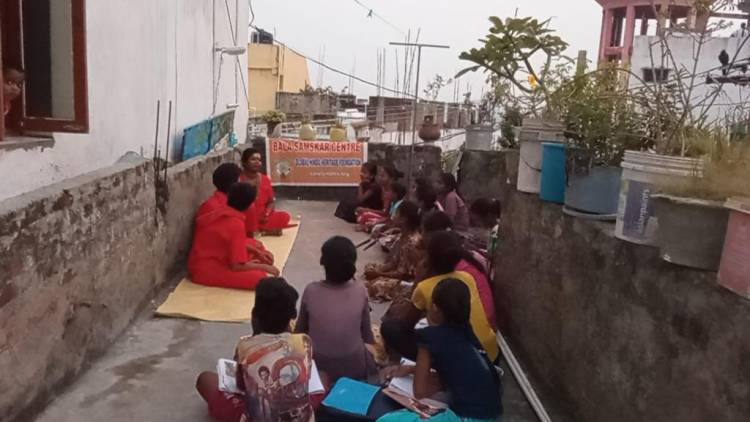[GHHF] Bala Samskar Kendras – Students learned about Swami Rama Tirtha, his life, his travels, and achievements.
 "All agree that the ancient Indians already operated with a time span of truly astronomical proportions long before the earliest signs of natural science in ancient Greece. It is undeniable that ancient Indian texts present some astonishingly exact scientific calculations even by today's latest scientific standards, such as the speed of light, exact size of the smallest particles and the age of the universe." Robert C Priddy
"All agree that the ancient Indians already operated with a time span of truly astronomical proportions long before the earliest signs of natural science in ancient Greece. It is undeniable that ancient Indian texts present some astonishingly exact scientific calculations even by today's latest scientific standards, such as the speed of light, exact size of the smallest particles and the age of the universe." Robert C Priddy
Global Hindu Heritage Foundation initiated Bala Samskar Kendras to instill morals, ethics, and principles in the lives the students at an incredibly young age. They will shape their personalities and character. They will allow them to distinguish between right and wrong as well as good and bad. Moral values will build good character at individual level and respect for law and order at the societal level. This week they learned about Swami Rama Tirtha.
Swami Rama Tirtha pronunciation (22 October 1873 – 17 October 1906, also known as Ram Soami, was an Indian teacher of the Hindu philosophy of Vedanta. He was among the first notable teachers of Hinduism to lecture in the United States, travelling there in 1902, preceded by Swami Vivekananda in 1893 and followed by Paramahamsa Yogananda in 1920. During his American tours Swami Rama Tirtha spoke frequently on the concept of 'practical Vedanta' and education of Indian youth. He proposed bringing young Indians to American universities and helped establish scholarships for Indian students.
Biography
Rama Tirtha was born in a Punjabi Brahmin family to Pandit Hiranand Goswami on 22 October 1873 (Deepawali Vikram Samvat 1930) in the village of Muraliwala in the Gujranwala District of Punjab, Pakistan. His mother died when he was a few days old and he was raised by his elder brother Gossain Gurudas. After receiving a master's degree in mathematics from The Government College of Lahore he became professor of mathematics at Forman Christian College, Lahore.
A chance meeting with Swami Vivekananda in 1897 in Lahore inspired his later decision to take up the life of a sannyasi. Having become well known for his speeches on Krishna and Advaita Vedanta he became a swami in 1899 on the day of Deepawali, leaving his wife, his children and his professorial chair.
"As a sannyasi, he neither touched any money nor carried any luggage with him. In spite of it he went round the world."[8] A trip to Japan to teach Hinduism was sponsored by Maharaja Kirtishah Bahadur of Tehri: from there he travelled to the United States of America in 1902, where he spent two years lecturing on Hinduism, other religions and his philosophy of "practical Vedanta". He frequently spoke about the iniquities of the caste system in India and the importance of education of women and of the poor, stating that "neglecting the education of women and children and the laboring classes is like cutting down the branches that are supporting us – nay, it is like striking a death-blow to the roots of the tree of nationality." Arguing that India needed educated young people, not missionaries, he began an organization to aid Indian students in American universities[5] and helped to establish a number of scholarships for Indian students.
He always referred to himself in the third person, which is a common spiritual practice in Hinduism to detach oneself from Ego.
Though upon his return to India in 1904 large audiences initially attended his lectures he completely withdrew from public life in 1906 and moved to the foothills of the Himalaya where he prepared to write a book giving a systematic presentation of practical Vedanta. It was never finished: He died on 17 October 1906 (Deepawali Vikram Samvat 1963).
Many believe he did not die but gave up his body to the river Ganges.
Prediction:
A significant prediction made by Swami Rama Tirtha for future India is quoted in Shiv R. Jhawar's book, Building a Noble World.[11] Rama Tirtha predicted: “After Japan, China will rise and gain prosperity and strength. After China, the sun of prosperity and learning will again smile at India.”
DONATIONS
PayPal Method: To donate visit our website: savetemples.org. Click on the Donate button, then press the Purpose category, and select the “Sunday School – Bal Samskar” category.
By Check: Or you can send a check payable to Global Hindu Foundation. It is tax-deductible.
By zelle: ghhfusaorg@gmail.com
By Rupees, please contact us by either phone or email.
For more information, call Prakasarao V Velagapudi; Email: ghhfusaorg@gmail.com





















 Urgent support needed for Bangladesh Hindus
Urgent support needed for Bangladesh Hindus 







